
On-Page Optimization (On-Site SEO) is the method of optimizing web page content so that it ranks higher in search engine results and generates more relevant traffic.
It refers to the process of optimizing a web page content for user and search engine visitors. Title tags, internal links, content, and URLs are standard on-page SEO techniques.
This is distinct from both off-page SEO and technical SEO, which focuses on signals that occur outside of your website (for example, backlinks) and the technical aspects of your website, respectively.
In terms of social media, although there is no direct link between social media and SEO rankings, the links you distribute across social media platforms help to boost brand awareness.

What Is the Importance of On-Page SEO?
Is there still a place for traditional On-Page optimization in 2022?
Yup!
Even though Google is far more advanced now than in the past, they still use old-school technology (like looking for a specific keyword on your page). And there’s evidence to support this.
We found no link between keyword-rich title tags and first-page ranks in our examination of 11 million Google search results.
However, if you search for any competitive phrase, you’ll see that practically all of the top-ranking pages include that precise keyword in their title tag.
As a result, there’s more to on-page SEO than stuffing keywords into the HTML of your page. To rank your content in 2022, you must additionally optimize it for:
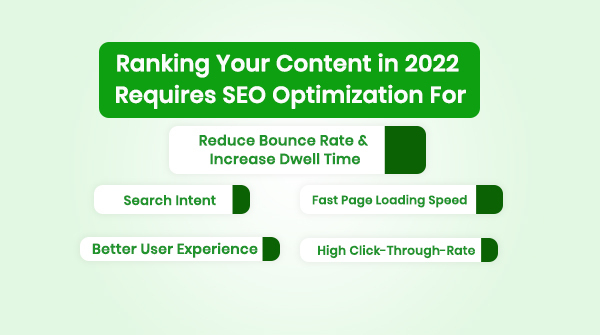
Now that you’ve learned why on-page SEO is still essential, it’s time to start optimizing your content. In this section, I’ll show you how to use keywords to optimize each page of your website.
If you’ve ever wondered, “How do I use keywords on my page?” you’ll appreciate the practical advice in this chapter.
In the first 100 words, use your target keyword. This is a tried-and-true On-Page optimization strategy that still works. Simply use your primary keyword once in the first 100-150 words of your content.

For instance, I mentioned the phrase “email marketing” right away in my post built around it.
What is the significance of this?
Google gives the terms that appear first on your website more weight. That’s understandable. Assume you’ve recently written an article about Web design. Would it make sense to include the word “Web design” halfway down the page if your article was indeed about The Keto Diet?
Obviously not.
This is why your keyword should appear within the first 100 words. This is one of those small details that aid Google in determining the purpose of your page.
The H1 tag acts similarly to a small title tag.
Google claims that utilizing an H1 element “assists Google in understanding the page’s structure.” The H1 tag is usually added to your blog post title by most platforms (such as WordPress). You’re good to go if that’s the case.
However, this isn’t always the case. Ensure your title is encased in an H1 tag in your website’s code. And your keyword is contained within the H1 tag.
At least one subheading should contain your desired keyword. Add an H2 tag to that subheading.
Will your On-Page optimization be made or broken by an H2 tag?
Nope. It can’t hurt, though. And based on my SEO tests, wrapping your target keyword in an H2 element can make a difference.
The term “keyword frequency” refers to the number of times your keyword appears in your material. Google may argue that employing the same keyword several times is ineffective. However, SEO experts with years of expertise will tell you that it works.
Consider the following scenario:
Assume you have a page that Google considers about a given term. However, that keyword appears only once on the website.
Can they be sure that the page is about that keyword? Not at all.
On the other hand, if the keyword is used ten times on a page, Google may be more confident in the topic. To be crystal clear:
This isn’t a case of keyword stuffing or anything. It’s as simple as repeating your target keyword a few times to show Google that your page is truly about that subject.
External links to linked pages guide Google in determining the topic of your page. It shows Google that your page is a reliable source of information.
This isn’t just a hypothesis. Reboot Online experimented to explore if external links could help improve rankings.
They built ten new websites. The authoritative sites were linked to half of the websites (like Oxford University). There were no external links on the other half.
Websites with external links also outperformed those without.
The structure of your URLs is an underappreciated aspect of On-Page optimization.
Yes, Google started using strange versions of URLs in search results a while ago. Even so, the terms you use in your URL will appear here. In addition, URLs are now shown above the title tag in the mobile and desktop SERPs. As a result, I would argue that your URL is now more significant than it was previously.
With that out of the way, here we have listed how to make SEO-friendly URLs:
Seriously. That is all there is to it.
This section will show you how to make your title and meta descriptions SEO-friendly.
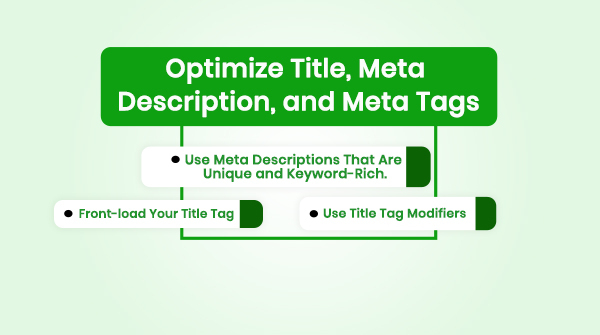
Title tags, according to Google, “assist a lot” with rankings.
As a result, they’re well worth optimizing.
And your description tells the same story. Google may not use your description to understand the content on your page, but searchers use it to determine which result to click on.
This section is for you to build SEO-friendly title tags and descriptions.
Your title tag should be placed at the front of the page. The most crucial On-Page optimization aspect, in my opinion, is your title tag.
This is because your title tag provides a high-level description of what your website is about to search engines.
The closer a keyword is to the beginning of the title tag, the greater weight it has with search engines, in my experience. Your keyword doesn’t have to appear right at the start of your title. It isn’t always practical to do so.
However, the closer your title is to the beginning of the title tag, the better.
Modifiers for Title Tags should be used. Modifiers such as “best,” “guide,” “checklist,” “quick,” and “review” can help you rank for long-tail variations of your target keyword. For example, the modifiers “best” and “free” are used in our SEO tools post. We may rank for long-tail variations of “SEO tools,” such as “top free SEO tools,” in this fashion.
You can go much further with your planning.
You should write your meta descriptions, according to Google. (Even if Google can overrule them with their snippets.)
Because a solid meta description makes your result stand out, it can increase your organic click-through rate. You should also include your keyword in your description at least once.
Why?
Because Google highlights terms relevant to the user’s inquiry, again, this can help you increase your CTR.
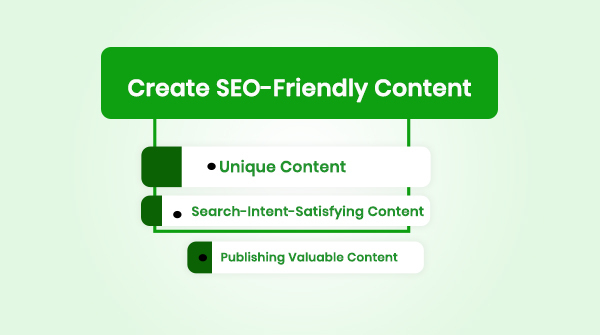
Now is the moment to create content worthy of being ranked first. This method entails a lot more than just putting keywords on your page. To rank in 2022, your material must be:
And in this section, I’ll tell you how to make sure your SEO content meets all three criteria.
I’m not simply discussing duplicating content when I say “unique.” I’m referring to publishing something that isn’t just a rehash of what’s already out there.
To put it another way, content adds something new to the conversation.
This new thing could be:
Do you believe someone ranks because they use keywords frequently?
That is highly beneficial. However, using keywords alone isn’t enough for competitive terms.
Their page is at the top because it is one-of-a-kind. Sure, it contains general advice and tactics that can be found anywhere.
Publishing valuable content is a great place to start. However, this is insufficient. (After all, millions of blog posts are published every day.) When developing your SEO content marketing, there are just a few things to keep in mind. By performing keyword research and selecting the most appropriate target keywords, you are able to rank well in search engines for that precise topic.
As a result, it must be precious for your material to stand out and get recognized.
Here are a few ideas for making your SEO material extremely valuable:
Add details: Images, screenshots, and step-by-step instructions make it simple for someone to put your content into practice.
Crisp Writing: Strong copywriting will increase the engagement of your material.
Material that has been updated: New strategies, steps, and examples can make a big difference.
Authors who are experts: Most content is created by people who have never done what they’re advising you to do. Content created by a seasoned professional is almost always more helpful than content generated by a random freelancer.
The checklist itself is the most critical aspect of my SEO checklist post. It begins with easy-to-understand material. As you progress through it, it becomes more advanced. Always include examples that are up to date, and content written by someone immersed in SEO daily.
You can go to the first page of Google with unique, valuable content. However, if you want to stay there, your page must meet the Search Intent criteria.
To put it another way:
Your page must contain EXACTLY what a Google searcher is looking for. If you don’t, your page will most likely end up on the third page. This is a costly blunder that any digital platform has to experience.
For two reasons, your organic click-through rate is crucial:
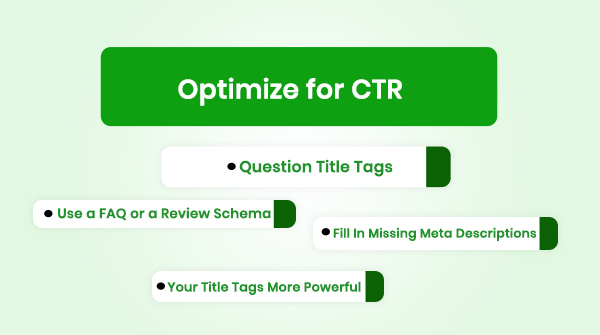
This chapter will show you five practical techniques to boost your organic CTR.
“Question Title Tags” should be used.
We looked over 5 million Google search results a few years ago to see why some pages get more clicks than others. One of the most exciting results was that question-based title tags have a higher CTR than average. As a result, I propose checking title tags with a question whenever it seems to make sense.
Meta descriptions were discussed in Chapter 1 as well.
I specifically mentioned that your descriptions should be highly captivating. However, you don’t have to create a fantastic description every time. It’s possible that simply having a meta description is sufficient.
We discovered that pages with a meta description received around 6% more clicks than pages without one.
To locate pages that don’t have a meta description, I propose conducting an SEO audit on your site. Then, for pages that require them, add descriptions.
Schema isn’t directly beneficial to your SEO. However, certain sorts of Schema can help you get Rich Snippets.
On the other hand, Rich Snippets CAN help you acquire more clicks.
Review Schema and And FAQ Schema are two of the best sorts of Schema for acquiring Rich Snippets. The Structured Data Testing Tool can help you double-check if your Schema is set up correctly.
Our CTR analysis discovered that emotional titles were clicked on 7 percent higher than titles without a strong emotional sense. We also noticed that emotionally charged “Power Words” had a 12 percent lower click-through rate.
What’s going on?
People are drawn to names that elicit strong emotions to a degree. When a title goes too far, it appears to be clickbait.
They’ll then click on a different result that appears to be less spammy.
Bottom line: Inject some emotion into your title tags. However, avoid using words like “crazy” and “powerful,” which can make your headline appear clickbait.
Including the year in your title and description will not affect your CTR. However, in my experience, it does assist… Especially for content that can quickly become outdated.
Someone looking for “Seneca philosophy,” for example, does not require something published just a few months ago.
People want to make sure they’re reading something current when searching for a keyword like “best cell phones.”
In addition, including the year in your title and description shows that your content is current.
This UX Signals section will show you how to optimize your content for “UX Signals”. (To put it another way, how Google users engage with your material.)
Is it true that Google considers Dwell Time, Bounce Rate, and other user engagement signals?
Yes.
In reality, according to Google’s “How Search Works,” they “use aggregated and anonymized interaction data to determine whether search results are relevant to queries” to help them rank the top results.
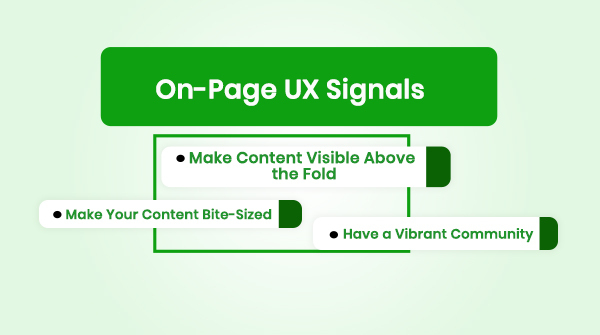
Now it’s time to show you how to keep Google searches on your website with your content.
When someone comes to your site through Google, they expect a quick response.
This is why large photos above the fold should be avoided. Instead, make your headline and introduction the focal point of your page. To be clear, having a picture at the top of your post is acceptable. However, if it pushes your material to the bottom of the page, that’s a terrible thing.
Visitors may read every word on your page in an ideal world. However, we do not live in a perfect world.
This is why you should make your content extremely skimmable. At Ultrabyte, I spent a significant amount of effort on this. I try to make extensive use of H2 subheadings, Images, and bullets.
Having a blog community is like having a Bounce Rate cheat code. Why?
After they’ve finished reading your piece, a high-quality comments section gives them something to read.
This is because comments provide context to your content. Contribute new techniques and strategies, and, on occasion, add a dash of controversy, as well as anything else that will keep people riveted to your page.
The final chapter lists some of my favorite on-page SEO strategies.

So, once you’ve fully optimized your page’s title and H1 tags, there are a few pointers to assist you in improving your On-Page optimization.
Let’s get to the strategies right now.
Do you include stock photos in your articles? On the other hand, those stock images could be damaging your SEO.
Sites that used original images outperformed those that used stock photos. Consider producing bespoke images if you’re using stock photos that a thousand other websites are using.
This is something Ultrabyte does. These original photographs, at least according to this small study, are likely to assist us in ranking.
Internal linking is highly conducive to SEO.
You want to link from your site’s high-authority pages to pages that need to be promoted. Be careful to use keyword-rich anchor text when you do so. With that out of the way, here’s the method I employ and recommend.
First, utilize an SEO tool such as Ahrefs “Indexed pages” report to find the pages on your website that have the most link authority. Then, add a few internal links to a high-priority page on your site from those sites. Check out Wikipedia for a beautiful example of how to use internal links on your website. Every page has a plethora of keyword-rich internal links.
Google intends to display people’s material that provides them with everything they need in one place.
To put it another way, extensive content.
Your post will have a better chance of ranking if it covers the entire topic. And what’s the most straightforward approach to ensure that Google considers your material to be complete?
LSI keywords are synonyms used by Google to estimate the relevance of a page. Because I usually write long content, I don’t obsess over LSI keywords.
(If you have a lot of content, you’re more likely to apply LSI keywords naturally.) If you want to be sure you’re employing LSI keywords, run a Google search for your keyword and navigate to the “Searches Related to Something” section at the bottom of the page:
And include any that make sense in your article.
On the record, Google has acknowledged that page loading speed is an SEO ranking indication (and they recently made PageSpeed even more critical).
According to our survey of 5.2 million websites, moving to a speedier host can increase your site’s loading speed. Get rid of as many third-party writings as possible and lower the overall size of your page.
Every image on your website must have a descriptive filename and alt text.
This aids Google (and visually impaired users) comprehend what each image depicts.
Make at least one image optimized around your target keyword if it makes sense. In the end, utilize a filename that contains your desired term (for example, on-page-SEO-chart.png). Use the same keyword in your image alt tags as well. Another important reason to optimize your photos for SEO is that it gives search engines a hint about what your page is about, potentially helping it rank higher.
To put it another way, when Google comes across a page containing images of “blue widgets” and “green widgets,” it informs the user that “this page is about widgets.”
The position of your website in a Featured Snippet can have a significant impact on your click-through rate.
The only snag?
According to this industry study, you must already be on the first page to receive a Featured Snippet. This implies you’ll need to uncover first-page results with a Featured Snippet AND a keyword you’re ranking for.
Open whatever SEO software you use to find them. Also, look for pages on your site that rank on Google’s first page. Then look for terms that already have a Featured Snippet.
Then, check at Google’s Featured Snippet for each of those terms.
The popularity of voice search is undoubtedly increasing.
What’s the best approach to make your content voice search-friendly? Make a FAQ page.
According to our voice search SEO study, Google loves to pull voice search results from FAQ sites.